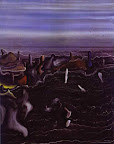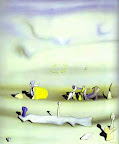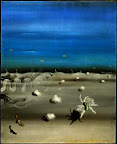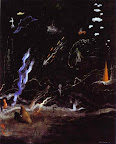Lucio Fontana
Lucio Fontana (19 February 1899 – 7 September 1968) was a painter and sculptor born in Rosario, province of Santa Fe,
Argentina, the son of an Italian father and an Argentine mother.
He was mostly known as the founder of Spatialism. Fontana spent the first years of his life in Italy and came back to Argentina in 1905, where he stayed until 1922, working as a sculptor along with his father and then on his own. In 1928 he returned to Italy, and there he presented his first
exhibition in 1930, organized by the Milano art gallery Il Milione.
During the following decade he journeyed Italy and France,
working with abstract and expressionist painters. In 1940 he returned to Argentina. In Buenos Aires (1946)
he founded the Altamira academy together with some
of his students, and made public the White Manifesto,
where he states that "Matter, colour and sound in motion are the phenomena whose simultaneous development makes
up the new art". Back in Milano in 1947, he supported,
along with writers and philosophers, the first manifesto
of spatialism (Spazialismo)**. He also resumed his ceramics works in Albisola. From 1958 on he started the so-called slash series, consisting
in holes or slashes on the painting surface, drawing a sign of
what he named "an art for the Space Age". In 1959 he exhibited cut-off paintings with multiple combinable elements (he named the sets quanta). He participated
in the Bienal de São Paulo and in numerous exhibitions in Europe (including London and Paris) and Asia, as well as New York. Shortly before his death he was present at the "Destruction Art, Destroy to Create" demonstration
at the Finch College Museum of New York. Then he left his
home in Milano and went to Comabbio (in the province
of Varese, Italy), his family's mother town, where he died in 1968. Fontana's works can be found in the permanent
collections of more than one hundred museums
around the world. He was the sculptor of the bust
of Ovidio Lagos, founder of the La Capital newspaper, in Carrara marble.
back to artist | 1899 | Born in Rosario de Santa Fe, Argentina | | 2003 | Died in Varese, Italy | | FIRST SOLO EXHIBITION | | 1931 | Galleria del Milione, Milan | | SELECTED RECENT EXHIBITIONS | | 1987-88 | "Lucio Fontana," Musιe national d'art moderne,
Centre Georges Pompidou, Paris, 1987-88,
La Fundaciσn 'la Caixa' Barcelona, Stedelijk Museum,
Amsterdam and the Whitechapel Art Gallery, London, 1988.
(catalogue) | | 1996-97 | "Lucio Fontana. Retrospektive Kunsthalle," Frankfurt, 1996,
Museum Moderner Kunst Stifung Ludwig, Vienna, 1997 (catalogue) | | 1998 | "Lucio Fontana, Palazzo delle Esposizioni," Roma, 1998 |
| Lucio Fontana. Entre Materia y Espacio, La Fundaciσn
'la Caixa' in collaboration with the Museo National Cantro
de Arte Reina Sofνa, Madrid, 1998 (catalogue) | | 1999 | "Fontana," Fondazione Lucio Fontana, Enrico Crispolti (ed.),
Edizioni Charta, Milan, 1999 (catalogue) |
| "Lucio Fontana,'Stasera inauguro la mia mostra da Palazzoli',"
Galleria Blu, Milan, 23 March - 20 May, 1999 (catalogue) | | 1999-2000 | "Lucio Fontana," Hayward Gallery, London, 14 October 1999 - 9
January 2000 (catalogue) | | 2000 | "Lucio Fontana," 11 Duke Street Limited, London, 27 January - 31
March, 2000 |
| "Lucio Fontana," Sperone Westwater, New York 16 February - 25
March, 2000 (catalogue) | | 2002 | De Pury & Luxembourg, Zurich, October 10-December 10. | | 2004 | "Lucio Fontana," Museum Franz Gertsch, Burgdorf, Switzerland,
10 April- 27 June (catalogue). | | 2006 | �Lucio Fontana: Venice/New York� Peggy Guggenheim Collection,
Venice, Italy, 4 June � 24 September 2006. | | RECENT GROUP SHOWS | | 1998-99 | "Gold. Gothic Masters and Lucio Fontana,
" Compagnia Di Belle Arti, Milan,
27 November 1998 - 17 January 1999, Sperone Westwater, New York, 23 January - 13 February, 1999 (catalogue) | | 1999-2000 | "Minimalia; An Italian Vision in 20th-century Art,
" P.S. 1, New York, October 1999 - January 2000 | | 2000 | "Cosmologies" Sperone Westwater, New York, 4 May - 10 June 2000 |
| "Against Nature": Alberto Burri, Lucio Fontana, Piero Manzoni, Sperone Westwater, New York, 14 September - 28 October | | 2003 | "Thinking About Sculpture," The Rachofsky House, Dallas, Texas, 2003-2004. | | 2004 | "Beyond Geometry: Experiments in Form 1940s-70s," Los Angeles County Museum of Art, 13 June-3 October.
|
| "Seeing other people," Marianne Boesky Gallery,
New York, NY, 18 June-13 August, 2004. | | 2005 | "Drawings from the Modern, 1945-1975,"
The Museum of Modern Art, New York, 30 March-29 August 2005. |
| "Figura," Galleria Tega, Milan, Italy, 10 November 2005. | | 2005-2006 | "Part Object, Part Sculpture," Wexner Center
for the Arts, Columbus, Ohio 30 October 2005-26February 2006. | | 2006 | "Carla Accardi & Lucio Fontana: Infinite Space,
" Sperone Westwater, New York, 6 Janurary - 25 February 2006. |
| �Line and Surface: Works on Paper,� Peter Blum,
New York, 20 January � 25 March 2006. | | 2007 | "Italian Visions: 40 Years of Art," Vivian Horan Fine Art,
New York 20 February - 13 April 2007. | | SELECTED BIBLIOGRAPHY | | 1987 | Lucio Fontana. Musιe national d'art moderne,
Centre Georges Pompidou, Paris, 1987-88,
La Fundaciσn 'la Caixa' Barcelona, Stedelijk Museum,
Amsterdam and the Whitechapel Art Galleery, London,
1988. (A smaller, English/Dutch bilingual edition of the
Paris catalogue was produced for the Stedejelijk and
Whitechapel showings.) | | 1996-98 | Lucio Fontana. Retrospektive Kunsthalle, Frankfurt, 1996,
Museum Moderner Kunst Stifung Ludwig, Vienna, 1997 | | 1998 | Lucio Fontana. Palazzo delle Esposizioni, Roma, 1998 |
| Lucio Fontana. Entre Materia y Espacio, La Fundaciσn
'la Caixa' in collaboration with the Museo National
Cantro de Arte Reina Sofνa, Madrid, 1998 | | 1999 | Fontana. Fondazione Lucio Fontana, Enrico Crispolti (ed.),
Edizioni Charta, Milan, 1999 |
| Whitfield, Sarah, "Curating Fontana," Modern Painters,
Vol. 12, No 3 (autumn 1999), p 114 |
| Anton, Saul, "Circus Minimus," Time Out,
(November 11-18,1999) p 85 |
| Cohen, Mark Daniel, "Lucio Fontana," Review,
(November 15, 1999) pp. 11-13 |
| Lucio Fontana, exhibition catalogue by
Sarah Whitfield (Hayward Gallery, London, 1999) |
| Lucio Fontana, exhibition Brochure by Susan
Cotter (Hayward Gallery, London, 1999) |
| Pickstone, Charles,"Not Letting go of God: Lucio
Fontana at the Hayward," The Month, (December 1999)
pp.493-495 |
| Taylor, John Russel, " December choices
," Prospect Magazine, (December 1999) | | 2000 | Groom, Simon, "Fontana, Boetti and Pistoletto,
" Modern Painters, (Winter 2000) pp. 113-114 |
| Vetrocq, Marcia E., "Minimalia; A Matter of the Mind,
" Art in America, vol. 88, no.1 (January 2000) pp.88-95 |
| Cone, C., Michele, "Minimalia" ARTnews, vol 99, no.1,
(January 2000) p.162 |
| Lucio Fontana, exhibition catalogue,
(Sperone Westwater, New York, 2000) |
| Shone, Richard, "Lucio Fontana," Artforum,
XXXVIII, no.0 (February 2000) p.113 |
| Gleadell, Colin " Contemporary market,
" The Daily Telegraph, (Monday February 14, 2000) p.18 |
| Gleadell, Colin " Fontana Market Regains Confidence,
" ARTnewsletter, Vol XXV, No. 13 ( February 22, 2000) pp. 6-7 |
| Cohen, Mark Daniel, "Lucio Fontana," Review,
(March 1, 2000) pp. 30-33 |
| Petersen, Stephen, "from Matter to Light," Art On Paper, Vol. 4, No. 4 (March-April 2000) pp. 52-57 |
| Prose, Francine, 'Fabulous Fontana," Edificerex.com, (March 3, 2000) |
| Smith, Roberta, "Lucio Fontana," The New York Times, (Friday, March 17, 2000) p. E37 |
| Morgan, Morgan C., "Lucio Fontana," Review (March 15, 2000) pp.18-19 |
| Bell, Bowyer J., "Lucio Fontana," Review (March 15, 2000) pp. 40-42 | | 2003 | Tully, Judd, "Lucio Fontana," Art & Auction, March 2003, pp. 88-89 |
| E.B., "Lucio Fontana drawings, Stadtische Galerie Villingen-Schwenningen," The Art Newspaper, No. 142, December 2003, p. 24 | | 2004 | Von Faber-Castell, Christian, "Fragonard to Fontana," ARTnews, May 2004, p. 86 | | 2005 | Garrels, Gary. "Drawing from the Modern, 1945-1975," Exhibition Catalogue 2005, The Museum of Modern Art, 2005. |
| Molesworth, Helen. �Part Object Part Sculpture,� Exhibition catalogue. Columbus, OH: Wexner Center for the Arts, Ohio State University, 2005. | | 2006 | �Infinite Space: Carla Accardi & Lucio Fontana,� exhibition catalogue, Sperone Westwater, New York, 2006. |
| "Maestri Moderni e Contemporanei, antologia scelta, 2006," Tornabuoni Arte, pp. 146-153. |
| Sholis, Brian. �New York Critic�s Picks,� Artforum online, 16 January 2006. |
| Johnson, Ken. �Listings,� The New York Times, 10 February 2006. |
| Montreuil, Gregory. �Historical Innovations,� Gay City News, 16 February 2006. |
| Mangini, Elizabeth. �Preview: Lucio Fontana,� Artforum, May 2006, p. 150. | |




























